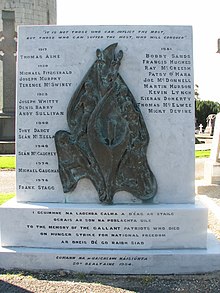Thomas Ashe
Thomas Ashe was born in the townland of Kinard East, Lispole, Dingle, County Kerry, Ireland, to Gregory Ashe (d. 1927), a farmer, and his wife Ellen Hanifin, on 12 January 1885, according to his baptismal record and his sister Nora,[2][3] or 15 March 1885, according to state birth records.
Having entered De La Salle Training College, Waterford, in 1905 he began his teaching career as principal of Corduff National School, Lusk, County Dublin, in 1908.
He was fond of the Irish language and started branches of the Gaelic League in Skerries and other neighbouring villages.
[11] He was to contact the 1st battalion at Cross Guns Bridge, although he found no one there because vice-commandant Piaras Beaslai knew nothing of this plan.
The area was dominated by the central feature of Broadstone station, at the end of the line to Athlone, an important British army barracks.
But for some reason they decided not to occupy and garrison the station; similarly the Citizens Army had been confusingly required to withdraw from Mallin.
The lack of cooperative communication was later discussed in Piaras Beaslai's books, the research for which included taking accounts from Thomas Ashe whilst they were incarcerated.
The battalion won a major victory at the Battle of Ashbourne, County Meath[14][15] where they engaged a much larger force capturing a significant quantity of arms and up to 20 Royal Irish Constabulary (RIC) vehicles.
Eleven RIC members, including County Inspector Alexander Gray, and two volunteers were killed during the five-and-a-half-hour battle.
With the entry of the US into World War I in April 1917, the British government was put under more pressure to solve the "Irish problem".
De Valera, Ashe and Thomas Hunter led a prisoner hunger strike on 28 May 1917 to add to this pressure.
In August 1917, Ashe was arrested and charged with sedition for a speech that he made in Ballinalee, County Longford, where Michael Collins had also been speaking.
[23] They concluded that Ashe had died of heart failure and congestion of the lungs, and that this was due to force-feeding combined with the previous removal of his bed and boots (which had left him in a physically weakened state).
Michael O'Flanagan on Friday morning before removal to City Hall, where his body lay in state for two days.
[27] "Tom Ashe's body lay in state in the City Hall, dressed in his Volunteer Republican uniform, and 30,000 mourners filed by.


